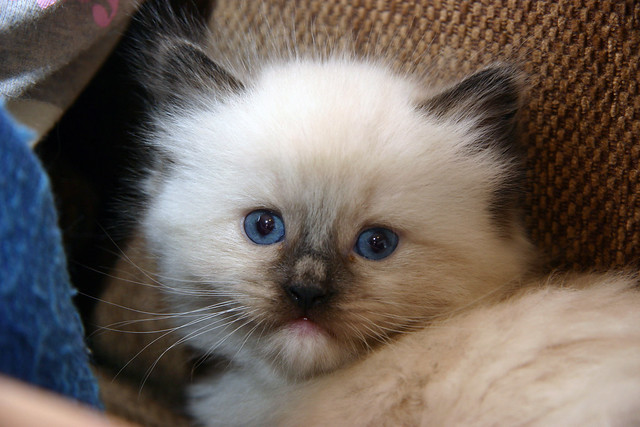 |
| Photo by roxeteer |
Using Daddy Warbucks as a stud, Baker bred a sufficient amount of kittens to launch the Ragdoll breed.
Ragdolls come in an assortment of color patterns. The established colors include blue, seal, lilac, and chocolate. These colors come in any of the following patterns: mitted, bi-color and pointed.
Lately, there's been an influx of new colors and patterns emerging in the Ragdoll breed. Newer colors comprise red (flame), cream, chocolate, and tortie. The lynx, or striped pattern, is also a newer trait that's become very prevalent. Just recently, solid color Ragdolls are being bred.
The body of a Ragdoll is long, robust, and powerful. These are big cats, the only bigger purebred cat is the Maine Coon. While Ragdolls are long, they are not tall. Their legs are squat and stout.
It's apparent that the Ragdoll is a gorgeous animal, but the cats are most famous for their sociable and passive personality. Ragdolls were named after their tendency to go limp when held, similar to a toy ragdoll.
Ragdolls have been titled "a dog-like cat." They are tremendously faithful and devoted to their owners, often following them around the house from room to room. Many Ragdolls love walking outside on a leash, and they can be trained to play "fetch."
This breed is the best family pet. They are very placid with children and normally enjoy being helped. Ragdolls usually are friendly with other family pets.
They have a soft voice and are naturally not loud animals. Though they do have a distinctive tweeting noise they'll make while playing - mostly with another animal.
Since the Ragdoll is so passive and amiable, they are to be only indoor cats. These cats were not bred to comprehend self-protection, and if let outdoors alone, they will indeed become hurt or taken.
The Ragdoll is also an extremely sociable animal, and would not do well if left isolated for the majority of the day. If the condition at home necessitates long periods of time in isolation, it is greatly suggested that another Ragdoll or pet is obtained to keep the cat company. If not, being alone often leads to unhappiness and nervousness in the Ragdoll cat.
If you are interested in buying a Ragdoll for your family, there are several trustworthy breeders throughout the world. However, always use care when purchasing any animal - whether from a pet store, breeder, or humane society.
Ask plenty of questions about how the cats are bred, reared, and tended to. Likewise, it's always smart to go to the breeder's house and confirm the animals are properly cared for.
Furthermore, it's vital to get all essential paperwork when buying a cat from a breeder. This includes official Ragdoll breed paperwork, all medical paperwork, and any genetic testing done on the kitten's parents.
While Ragdolls are usually resilient and vigorous animals, one disorder to be aware of is HCM or Hypertrophic Cardiomyopathy. This disorder has been found in some Ragdoll line s and is fatal.
s and is fatal.
Always confirm the breeder has tested the parents for the Ragdoll HCM gene before buying a cat. It's better to get a photocopy of the paperwork, instead of a spoken guarantee from the breeder.

No comments:
Post a Comment